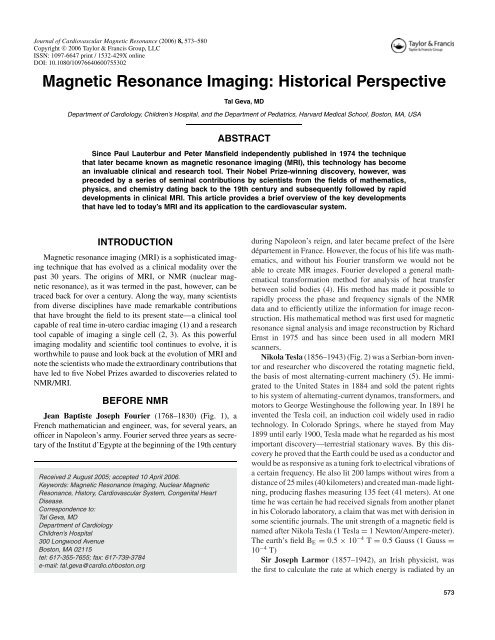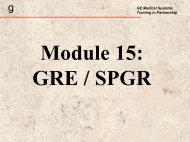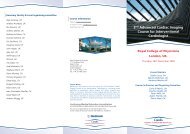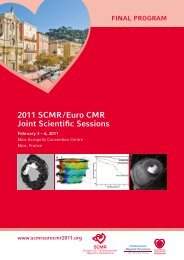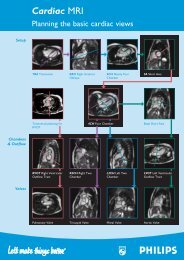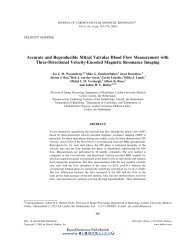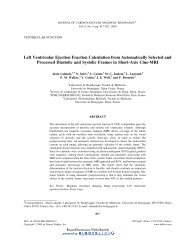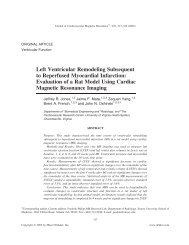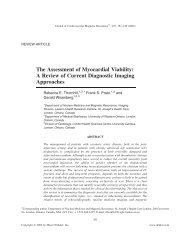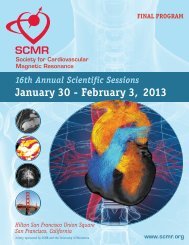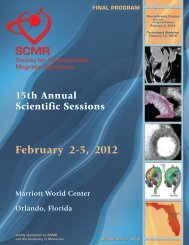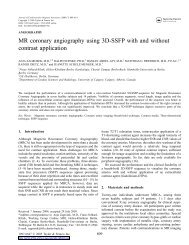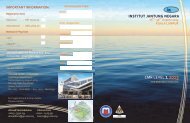Magnetic Resonance Imaging: Historical Perspective - Society of ...
Magnetic Resonance Imaging: Historical Perspective - Society of ...
Magnetic Resonance Imaging: Historical Perspective - Society of ...
Create successful ePaper yourself
Turn your PDF publications into a flip-book with our unique Google optimized e-Paper software.
Journal <strong>of</strong> Cardiovascular <strong>Magnetic</strong> <strong>Resonance</strong> (2006) 8, 573–580<br />
Copyright c○ 2006 Taylor & Francis Group, LLC<br />
ISSN: 1097-6647 print / 1532-429X online<br />
DOI: 10.1080/10976640600755302<br />
<strong>Magnetic</strong> <strong>Resonance</strong> <strong>Imaging</strong>: <strong>Historical</strong> <strong>Perspective</strong><br />
Tal Geva, MD<br />
Department <strong>of</strong> Cardiology, Children’s Hospital, and the Department <strong>of</strong> Pediatrics, Harvard Medical School, Boston, MA, USA<br />
ABSTRACT<br />
Since Paul Lauterbur and Peter Mansfield independently published in 1974 the technique<br />
that later became known as magnetic resonance imaging (MRI), this technology has become<br />
an invaluable clinical and research tool. Their Nobel Prize-winning discovery, however, was<br />
preceded by a series <strong>of</strong> seminal contributions by scientists from the fields <strong>of</strong> mathematics,<br />
physics, and chemistry dating back to the 19th century and subsequently followed by rapid<br />
developments in clinical MRI. This article provides a brief overview <strong>of</strong> the key developments<br />
that have led to today’s MRI and its application to the cardiovascular system.<br />
INTRODUCTION<br />
<strong>Magnetic</strong> resonance imaging (MRI) is a sophisticated imaging<br />
technique that has evolved as a clinical modality over the<br />
past 30 years. The origins <strong>of</strong> MRI, or NMR (nuclear magnetic<br />
resonance), as it was termed in the past, however, can be<br />
traced back for over a century. Along the way, many scientists<br />
from diverse disciplines have made remarkable contributions<br />
that have brought the field to its present state—a clinical tool<br />
capable <strong>of</strong> real time in-utero cardiac imaging (1) and a research<br />
tool capable <strong>of</strong> imaging a single cell (2, 3). As this powerful<br />
imaging modality and scientific tool continues to evolve, it is<br />
worthwhile to pause and look back at the evolution <strong>of</strong> MRI and<br />
note the scientists who made the extraordinary contributions that<br />
have led to five Nobel Prizes awarded to discoveries related to<br />
NMR/MRI.<br />
BEFORE NMR<br />
Jean Baptiste Joseph Fourier (1768–1830) (Fig. 1), a<br />
French mathematician and engineer, was, for several years, an<br />
<strong>of</strong>ficer in Napoleon’s army. Fourier served three years as secretary<br />
<strong>of</strong> the Institut d’Egypte at the beginning <strong>of</strong> the 19th century<br />
Received 2 August 2005; accepted 10 April 2006.<br />
Keywords: <strong>Magnetic</strong> <strong>Resonance</strong> <strong>Imaging</strong>, Nuclear <strong>Magnetic</strong><br />
<strong>Resonance</strong>, History, Cardiovascular System, Congenital Heart<br />
Disease.<br />
Correspondence to:<br />
Tal Geva, MD<br />
Department <strong>of</strong> Cardiology<br />
Children’s Hospital<br />
300 Longwood Avenue<br />
Boston, MA 02115<br />
tel: 617-355-7655; fax: 617-739-3784<br />
e-mail: tal.geva@cardio.chboston.org<br />
during Napoleon’s reign, and later became prefect <strong>of</strong> the Isère<br />
département in France. However, the focus <strong>of</strong> his life was mathematics,<br />
and without his Fourier transform we would not be<br />
able to create MR images. Fourier developed a general mathematical<br />
transformation method for analysis <strong>of</strong> heat transfer<br />
between solid bodies (4). His method has made it possible to<br />
rapidly process the phase and frequency signals <strong>of</strong> the NMR<br />
data and to efficiently utilize the information for image reconstruction.<br />
His mathematical method was first used for magnetic<br />
resonance signal analysis and image reconstruction by Richard<br />
Ernst in 1975 and has since been used in all modern MRI<br />
scanners.<br />
Nikola Tesla (1856–1943) (Fig. 2) was a Serbian-born inventor<br />
and researcher who discovered the rotating magnetic field,<br />
the basis <strong>of</strong> most alternating-current machinery (5). He immigrated<br />
to the United States in 1884 and sold the patent rights<br />
to his system <strong>of</strong> alternating-current dynamos, transformers, and<br />
motors to George Westinghouse the following year. In 1891 he<br />
invented the Tesla coil, an induction coil widely used in radio<br />
technology. In Colorado Springs, where he stayed from May<br />
1899 until early 1900, Tesla made what he regarded as his most<br />
important discovery—terrestrial stationary waves. By this discovery<br />
he proved that the Earth could be used as a conductor and<br />
would be as responsive as a tuning fork to electrical vibrations <strong>of</strong><br />
a certain frequency. He also lit 200 lamps without wires from a<br />
distance <strong>of</strong> 25 miles (40 kilometers) and created man-made lightning,<br />
producing flashes measuring 135 feet (41 meters). At one<br />
time he was certain he had received signals from another planet<br />
in his Colorado laboratory, a claim that was met with derision in<br />
some scientific journals. The unit strength <strong>of</strong> a magnetic field is<br />
named after Nikola Tesla (1 Tesla = 1Newton/Ampere-meter).<br />
The earth’s field BE = 0.5 × 10 −4 T = 0.5 Gauss (1 Gauss =<br />
10 −4 T)<br />
Sir Joseph Larmor (1857–1942), an Irish physicist, was<br />
the first to calculate the rate at which energy is radiated by an<br />
573
Figure 1. Jean Baptiste Joseph Fourier.<br />
accelerated electron, and the first to explain the splitting <strong>of</strong> spectrum<br />
lines by a magnetic field (6). He was educated at Belfast and<br />
Cambridge and taught at Galway, Ireland from 1880 to 1885. He<br />
then went to Cambridge, becoming Lucasian Pr<strong>of</strong>essor there in<br />
1903. He worked on electricity and thermodynamics and wrote<br />
Aether and Matter in 1900. Knighted in 1909, Larmor served<br />
as MP for the University <strong>of</strong> Cambridge from 1911 to 1922. The<br />
Royal <strong>Society</strong> awarded him its Royal Medal in 1915 and its Copley<br />
Medal in 1921. He was also awarded the De Morgan Medal<br />
<strong>of</strong> the London Mathematical <strong>Society</strong> in 1914. He is most famous<br />
in the field <strong>of</strong> NMR for the equation that bares his name—The<br />
Figure 2. Nikola Tesla.<br />
574 T. Geva<br />
Larmor equation. It states that the frequency <strong>of</strong> precession <strong>of</strong><br />
the nuclear magnetic moment (ω)isdirectly proportional to the<br />
product <strong>of</strong> the magnetic field strength (B0) and the gyromagnetic<br />
ratio (γ ): ω = γ B0. The Larmor equation is important<br />
because it is the frequency at which the nucleus will absorb energy.<br />
The absorption <strong>of</strong> that energy will cause the proton to alter<br />
its alignment and ranges from 1–130 MHz in MRI.<br />
EARLY NMR<br />
Gerlach and Stern: The roots <strong>of</strong> nuclear magnetic resonance<br />
(NMR)—the term used through the mid-1980’s—can be traced<br />
to the work <strong>of</strong> Walter Gerlach (1889–1979), who worked in<br />
Munich and Otto Stern (1888–1969), who worked in Hamburg.<br />
In 1924, they published the results <strong>of</strong> an experiment that demonstrated<br />
the quantum nature <strong>of</strong> the magnetic moment <strong>of</strong> silver<br />
atoms by molecular beam deflection in an inhomogeneous magnetic<br />
field (7).<br />
Isidor Rabi (1898–1988) (Fig. 3), a native Austrian who<br />
worked in the Department <strong>of</strong> Physics at Columbia University in<br />
New York, whose early work was concerned with the magnetic<br />
properties <strong>of</strong> crystals. In 1930, he began studying the magnetic<br />
properties <strong>of</strong> atomic nuclei, developing Stern’s molecular beam<br />
method to great precision as a tool for measuring these properties.<br />
His apparatus was based on the production <strong>of</strong> ordinary<br />
electromagnetic oscillations <strong>of</strong> the same frequency as that <strong>of</strong><br />
the Larmor precession <strong>of</strong> atomic systems in a magnetic field. He<br />
succeeded in detecting and measuring single states <strong>of</strong> rotation <strong>of</strong><br />
atoms and molecules, and in determining the magnetic moments<br />
<strong>of</strong> the nuclei (8). For his discoveries, he was awarded the Nobel<br />
Prize in Physics in 1944. CJ Gorter, attributing the term to Rabi,<br />
coined the term ‘Nuclear <strong>Magnetic</strong> <strong>Resonance</strong>’ in 1942 (9).<br />
Figure 3. Isidor Rabi.
Figure 4. Edward M. Purcell.<br />
Bloch and Purcell: In 1946, two scientists in the United<br />
States, Felix Bloch, working at Stanford University, and Edward<br />
Purcell from Harvard University, independently <strong>of</strong> each<br />
other, described a physicochemical phenomenon, which was<br />
based upon the magnetic properties <strong>of</strong> certain nuclei in the<br />
periodic system. Edward M. Purcell (Fig. 4) was born in<br />
Illinois, worked at the Massachusetts Institute <strong>of</strong> Technology,<br />
and later joined the faculty <strong>of</strong> Harvard University. Felix Bloch<br />
(Fig. 5) was born in Zurich in 1905 and taught at the University<br />
<strong>of</strong> Leipzig until 1933; he then immigrated to the United<br />
States and was naturalized in 1939. He joined the faculty <strong>of</strong><br />
Stanford University at Palo Alto in 1934 and became the first<br />
director <strong>of</strong> CERN in Geneva in 1962. He died in Zurich in<br />
1983.<br />
Bloch and Purcell found that when certain nuclei were placed<br />
in a magnetic field they absorbed energy in the electromagnetic<br />
spectrum, and re-emitted this energy when the nuclei<br />
returned to their original state. The strength <strong>of</strong> the magnetic<br />
field and the radi<strong>of</strong>requency matched each other according to<br />
the Larmor relationship. They measured the precessional signal<br />
<strong>of</strong> spins in water and paraffin samples subject to a magnetic<br />
field (10, 11). They jointly received the Nobel Prize in Physics<br />
in 1952.<br />
Erwin L. Hahn developed a method to study molecular diffusion<br />
in liquids by the spin-echo method using a gradient approach<br />
to create a storage memory (12).<br />
Figure 5. Felix Bloch.<br />
NMR RESEARCH 1940’s THROUGH 1970’s<br />
During those three decades, the field <strong>of</strong> NMR saw many investigations<br />
<strong>of</strong> non-biological and biological samples, including<br />
measurement <strong>of</strong> relaxation times in living cells, excised animal<br />
tissues, whole blood, plasma, red blood cells, skeletal muscle <strong>of</strong><br />
frog, and living human subjects. In 1971, Raymond Damadian,<br />
who worked at Downstate Medical Center in Brooklyn, New<br />
York, measured T1 and T2 relaxation times <strong>of</strong> excised normal<br />
and cancerous rat tissue and stated that tumor tissue had longer<br />
relaxation times than normal tissue. Damadian thought that he<br />
had discovered the ultimate technology to detect cancer and,<br />
in 1972, filed a patent claim for an ‘Apparatus and Method for<br />
Detecting Cancer in Tissue’ (Damadian R. United States Patent<br />
no. 3789832. Filed 17 March 1972, awarded 5 February 1974.<br />
Apparatus and method for detecting cancer in tissue. Inventor:<br />
Raymond V. Damadian). The patent included the idea but no<br />
description <strong>of</strong> a method or technique to use NMR to scan the<br />
human body. In February 1973, Abe and his colleagues applied<br />
for a patent on a targeted NMR scanner [Abe Zenuemon, Kunio<br />
Tanaka, Hotta Masao and Imai Masashi: [Patent] Application.<br />
Measurement method from the outside [to obtain] information in<br />
the inside applying nuclear magnetic resonance. Japanese patent<br />
application 48-l3508, 1973 (application day: February 2, 1973)].<br />
They published this technique in 1974 (13). Damadian reported a<br />
similar technique in a publication two years later, dubbed ’fieldfocusing<br />
NMR (Fonar),’ which contained an image <strong>of</strong> scanned<br />
volume elements through a mouse (14, 15).<br />
<strong>Historical</strong> <strong>Perspective</strong> <strong>of</strong> MRI 575
ORIGINS OF BLOOD FLOW<br />
MEASUREMENT BY NMR<br />
In 1959, Jay Singer,working at the University <strong>of</strong> California<br />
at Berkley, published an NMR method for measurement <strong>of</strong> blood<br />
flow in mice tails (16). In 1967, Alexander Ganssen filed a<br />
patent for a whole-body NMR machine to measure the NMR<br />
signal <strong>of</strong> flowing blood in the human body. The machine was<br />
designed to measure the NMR signal <strong>of</strong> flowing blood at different<br />
locations <strong>of</strong> a vessel using a series <strong>of</strong> small coils.<br />
FROM NMR SIGNAL TO IMAGE<br />
FORMATION<br />
All the experiments up to now had been one-dimensional<br />
and lacked spatial information. Nobody could determine exactly<br />
where the NMR signal originated within the sample. In<br />
1974, Paul C. Lauterbur, working in the United States, and<br />
Peter Mansfield, working in England, without knowledge <strong>of</strong><br />
each other’s work, described the use <strong>of</strong> magnetic field gradients<br />
for spatial localization <strong>of</strong> NMR signals. Their discoveries<br />
laid the foundation for <strong>Magnetic</strong> <strong>Resonance</strong> <strong>Imaging</strong> (MRI).<br />
For their contributions, Lauterbur and Mansfield were jointly<br />
awarded the 2003 Nobel Prize in Physiology or Medicine.<br />
Paul C. Lauterbur (Fig. 6) was born in 1929 in Sidney, Ohio.<br />
He received a Ph.D. degree in Chemistry from the University <strong>of</strong><br />
Pittsburgh in 1962, and from 1969 to 1985 he was a Pr<strong>of</strong>essor<br />
<strong>of</strong> Chemistry and Radiology at New York University at Stony<br />
Brook. While at Stony Brook, he had the idea <strong>of</strong> applying mag-<br />
Figure 6. Paul C. Lauterbur.<br />
576 T. Geva<br />
Figure 7. Peter Mansfield.<br />
netic field gradients in three spatial dimensions and used the<br />
computer-assisted tomography (CAT)-scan back-projection approach<br />
to create 2D NMR images. He published the first images<br />
<strong>of</strong> two 1 mm capillaries filled with water submerged in heavy<br />
water in March 1973 in the journal Nature (17). The article was<br />
initially rejected due to lack <strong>of</strong> interest for a wide readership.<br />
This was followed later in the year by the picture <strong>of</strong> a living animal,<br />
a clam, and in 1974 by the image <strong>of</strong> the thoracic cavity <strong>of</strong> a<br />
mouse. Lauterbur called his imaging method zeugmatography,<br />
a term which was later replaced by (N)MR imaging.<br />
Peter Mansfield (Fig. 7) was born in 1933 in London, UK.<br />
He studied physics at Queen Mary College in London where<br />
he received a Ph.D. degree in 1962. He worked in the Department<br />
<strong>of</strong> Physics at the University <strong>of</strong> Nottingham until retiring<br />
in 1994. Mansfield worked on studies <strong>of</strong> solid periodic objects<br />
such as crystals. In a letter to the editor in 1973, Mansfield and<br />
Grannell, who was a postdoctoral fellow at the time, described<br />
the use <strong>of</strong> magnetic field gradients to acquire spatial information<br />
in NMR experiments (18). At a Colloque Ampère conference<br />
in Cracow, Poland later that year, he and Grannell presented a<br />
one-dimensional MR interferogram to a resolution <strong>of</strong> better than<br />
1mm(19). While this cannot be considered an MR image, one<br />
year later, Garroway and Mansfield filed a patent and published<br />
a paper on image formation by NMR (20).<br />
In 1975, Richard Ernst described the use <strong>of</strong> Fourier transform<br />
<strong>of</strong> phase and frequency encoding to reconstruct 2D images.<br />
This technique is the basis <strong>of</strong> today’s MRI. In April 1974, Paul<br />
Lauterbur gave a talk at a conference in Raleigh, North Carolina.<br />
Richard Ernst attended this conference and realized that instead
Figure 8. Prototype MR scanner in Aberdeen, Scotland with Dr.<br />
Hutchinson.<br />
<strong>of</strong> Lauterbur’s back-projection, one could use switched magnetic<br />
field gradients in the time domain. This led to the 1975 publication<br />
that described for the first time a practical method to rapidly<br />
reconstruct an image from NMR signals (21). Richard Ernst<br />
wasrewarded for his achievements in pulsed Fourier Transform<br />
NMR and MRI with the 1991 Nobel Prize in Chemistry.<br />
The early contribution <strong>of</strong> computed tomography (CT) to MRI<br />
is worth noting. Hounsfield introduced x-ray-based CT in 1973<br />
(22, 23) the same year that Lauterbur and Mansfield introduced<br />
spatial localization <strong>of</strong> NMR signals to produce two-dimensional<br />
images. This date is important to the MRI timeline because<br />
it demonstrated the interest <strong>of</strong> the scientific and clinical communities<br />
in noninvasive cross-sectional in-vivo imaging. These<br />
two imaging technique have continued to this day to both compete<br />
and complement each other. Allan Cormack and Godfrey<br />
Hounsfield received the 1979 Nobel Prize in Physiology or<br />
Medicine for the development <strong>of</strong> computer assisted tomography.<br />
LATE 1970’s: EARLY MR IMAGES<br />
By 1975, Peter Mansfield and Andrew Maudsley proposed a<br />
line scan technique, which, in 1977, led to the first image <strong>of</strong> in<br />
vivo human anatomy, a cross section through a finger. In 1977,<br />
Hinshaw, Bottomley, and Holland succeeded with an image <strong>of</strong><br />
the wrist (24) and Damadian et al. created a cross section <strong>of</strong> a<br />
human chest (25). More human thoracic and abdominal images<br />
followed, and, by 1978, Hugh Clow and Ian R. Young, working<br />
at the British company EMI, reported the first transverse NMR<br />
image through a human head (26). Two years later, William<br />
Moore and colleagues presented the first coronal and sagittal<br />
images through a human head. In 1980, Edelstein et al. from<br />
Aberdeen University in Scotland demonstrated imaging <strong>of</strong> the<br />
body using Ernst’s technique (Fig. 8) (27). A single image could<br />
be acquired in approximately five minutes by this technique.<br />
By 1986, the imaging time was reduced to about five seconds<br />
without sacrificing too much image quality.<br />
EARLY 1980’s–PRESENT: CLINICAL<br />
APPLICATIONS<br />
The early 1980’s saw an intense interest in clinical applications<br />
<strong>of</strong> this new technique, which was still called NMR. Early<br />
clinical imaging was extremely difficult, time-consuming, and<br />
<strong>of</strong>ten disappointing. Spin-echo imaging was the workhorse <strong>of</strong><br />
clinical MRI and was mainly based upon proton-density differences.<br />
Later, spin echo sequences also incorporated differences<br />
in T1-weighting. By 1982–1983, several groups pointed out that<br />
long, heavily T2-weighted spin echo sequences were better at<br />
highlighting pathology (28, 29).<br />
CARDIAC MRI<br />
It is difficult to determine with certainty when cardiac MRI<br />
was first performed. The heart and great vessels could be recognized<br />
on some <strong>of</strong> the early MR images that included the chest, but<br />
these investigations were not directed at the cardiovascular system.<br />
In 1980, Goldman and colleagues from the Massachusetts<br />
General Hospital and Harvard Medical School in Boston predicted<br />
the future <strong>of</strong> clinical cardiac MR (30). Most <strong>of</strong> their<br />
predictions were realized in the course <strong>of</strong> the ensuing quarter<br />
century. In 1981, Hawkes and colleagues from the University <strong>of</strong><br />
Nottingham in the UK published a paper that was specifically<br />
directed at NMR imaging <strong>of</strong> the heart (31). Acquisition <strong>of</strong> a<br />
single image took 150 seconds with pixel dimensions <strong>of</strong> 4 × 4<br />
× 10 mm, interpolated to in-plane image display <strong>of</strong> 2 × 2 mm.<br />
The resultant images required corresponding anatomical sections<br />
and line drawing for illustration <strong>of</strong> the anatomy but were <strong>of</strong><br />
sufficient quality to excite the investigators to realize the clinical<br />
potential <strong>of</strong> cardiac MRI. In the introduction to their paper, the<br />
authors point out the advantages <strong>of</strong> MRI in terms <strong>of</strong> avoiding the<br />
hazards <strong>of</strong> ionizing radiation and the lack <strong>of</strong> known biological<br />
damage, and recognize the limitations imposed by cardiac and<br />
respiratory motion. They pointed out to the potential to overcome<br />
image blurring due to cardiac motion by using ECG-triggering,<br />
a technique that was first described by Berninger et al. in 1979 in<br />
aCTexperiment in dogs (32). Paul Lauterbur’s group, in an experiment<br />
in dogs, first reported ECG-gated cardiac MRI in 1983<br />
(33). A year later Higgins and colleagues from the University <strong>of</strong><br />
California in San Francisco (UCSF) reported cardiac imaging<br />
using gated MR in 3 volunteers who were study investigators.<br />
<strong>Historical</strong> <strong>Perspective</strong> <strong>of</strong> MRI 577
They tested three gating signal methods—peripheral pulse signals;<br />
Doppler flow signal; and ECG signal. The ECG triggering<br />
method proved superior to the other two and provided “sharp<br />
definition <strong>of</strong> internal cardiac morphology” (34).<br />
Rob Hawkes may not only have made the first image <strong>of</strong> a<br />
heart but have also worked on the earliest versions <strong>of</strong> the steady<br />
state free precession (SSFP) imaging sequence, which is now<br />
the workhorse <strong>of</strong> cardiac MRI. Hawkes joined the faculty at the<br />
Brigham and Women’s Hospital and Harvard Medical School<br />
in the early 1980’s, following his mentor Bill Moore, for whom<br />
an ISMRM prize is awarded every year. Bill Moore died on<br />
the squash court at Harvard while playing squash with Rob<br />
Hawkes (Robert V. Mulkern, PhD: personal communication).<br />
SSFP faded after its first incarnation due to inferior image quality<br />
as compared with other gradient echo imaging techniques. In<br />
the late 1990’s and early 2000’s, it came roaring back once magnets<br />
had better homogeneity and the echo and repetition times<br />
have dropped down due to advances in fast switching gradient<br />
hardware.<br />
In 1982, Peter Mansfield’s group from Nottingham reported<br />
real time cine MRI <strong>of</strong> live rabbit heart. Using single shot echo<br />
planar imaging (a technique previously described by the same<br />
group), they produced cine loop images consisting <strong>of</strong> 6 frames,<br />
each taking 32 ms to acquire (32 × 32 pixels interpolated to<br />
128 × 128) (35). In 1983, the group from UCSF reported NMR<br />
imaging <strong>of</strong> the heart and great vessels in 244 volunteers using<br />
a 0.35 T scanner (36). In the same year, Leon Axel’s group<br />
published a 3D display <strong>of</strong> cardiovascular anatomy imaged by<br />
NMR, demonstrating the 3D nature <strong>of</strong> MRI (37). In the ensuing<br />
years, the field <strong>of</strong> cardiac MRI has witnessed rapid growth in the<br />
clinical and research arenas (Fig. 9). Table 1 summarizes some<br />
<strong>of</strong> the milestones in the development <strong>of</strong> cardiovascular MR.<br />
Table 1. Milestones in cardiovascular MR<br />
Figure 9. The graph shows the annual number <strong>of</strong> publications identified<br />
by a search <strong>of</strong> the National Library <strong>of</strong> Medicine from 1977<br />
through 2004 for the terms NMR and cardiac, NMR and heart, MRI<br />
and cardiac, or MRI and heart.<br />
MRI OF CONGENITAL HEART DISEASE<br />
The same difficulty in ascertaining “firsts” in other areas<br />
<strong>of</strong> MRI exists when it comes to MRI <strong>of</strong> congenital heart disease.<br />
In 1982, Paul Lauterbur’s group published the first paper<br />
I could identify that specifically targets a congenital cardiac<br />
anomaly. They used NMR to produce 3D images <strong>of</strong> artificially<br />
created muscular ventricular septal defect in preserved lamb<br />
hearts (38). They concluded, “Results <strong>of</strong> these experiments suggest<br />
that NMR zeugmatography will become a valuable addition<br />
to existing imaging techniques for the study <strong>of</strong> congenital heart<br />
disease.” (39). Their prediction has manifested itself the quarter<br />
century that followed.<br />
MR Technique or Application Year Reference<br />
Static cardiac imaging 1981 (31)<br />
Dynamic cardiac imaging (“real time” echo planar gradient echo cine) 1982 (35)<br />
MR evaluation <strong>of</strong> congenital heart disease (ventricular septal defect) 1982 (38)<br />
Electrocardiographically-triggered cardiac MR 1983 (33)<br />
MR assessment <strong>of</strong> myocardial infarction 1983 (56)<br />
Blood flow measurements using phase velocity mapping 1984 (57, 58)<br />
Clinical use <strong>of</strong> Gadolinium-enhanced MRI 1984 (59–62)<br />
Steady state free precession MR 1986 (63)<br />
MR imaging <strong>of</strong> coronary artery anomaly 1987 (64)<br />
Myocardial tagging 1988 (65)<br />
Assessment <strong>of</strong> myocardial viability using late gadolinium enhancement* 1988 (66)<br />
First pass myocardial perfusion 1990 (67)<br />
Dipyridamole stress CMR 1990 (68)<br />
Dobutamine stress CMR 1992 (69)<br />
In-vivo MR catheter tracking 1995 (70)<br />
MR-guided cardiac catheterization in children 2003 (54)<br />
Note: Aswith other developments in science and medicine, it is difficult to determine with<br />
certainty when and by whom new techniques were invented or were first applied in the clinical<br />
arena. In most circumstances, progress is built upon prior work. The dates reflect the first<br />
published clinical application.<br />
∗ Use <strong>of</strong> gadolinium-DTPA in myocardial infarction was first published in 1984 (59).<br />
578 T. Geva
Early applications <strong>of</strong> MRI in pediatric cardiology mainly involved<br />
static imaging using ECG-triggered spin echo techniques<br />
(39). Beginning in the late 1980’s and early 1990’s, the use <strong>of</strong><br />
ECG-triggered gradient echo cine MR has gained acceptance as<br />
a useful tool for the assessment <strong>of</strong> ventricular function and blood<br />
flow in patients with congenital heart disease (40–43). During<br />
the same period, reports on measurements <strong>of</strong> blood flow rate and<br />
velocity by phase velocity cine MR in patients with shunt lesions<br />
and other congenital and acquired cardiac anomalies were first<br />
published (44–46). In the ensuing years, cardiovascular MRI<br />
rapidly gained acceptance as a useful clinical and research tool<br />
in patients with virtually all forms <strong>of</strong> congenital heart disease,<br />
ranging in age from newborns to adults (47, 48). Today, MRI is<br />
gradually replacing diagnostic cardiac catheterization in a variety<br />
<strong>of</strong> clinical circumstances such as anomalies <strong>of</strong> systemic and<br />
pulmonary venous anomalies (49), congenital anomalies <strong>of</strong> the<br />
coronary arteries (50), pre-bidirectional Glenn (or hemi-Fontan)<br />
shunt (51), coarctation <strong>of</strong> the aorta (52), before and after pulmonary<br />
valve replacement in patients with tetralogy <strong>of</strong> Fallot<br />
(53), and other conditions. Concurrently, new frontiers in pediatric<br />
cardiac MRI—MRI-guided cardiac catheterization (54)<br />
and fetal cardiac MRI (1)—are evolving.<br />
The maturation <strong>of</strong> cardiac MRI has brought with it new challenges.<br />
As a growing number <strong>of</strong> pediatric cardiac programs endorse<br />
MRI as integral to their practice, the demand for trained<br />
experts exceeds the number <strong>of</strong> physicians with sufficient training.<br />
In 2005, new ACC/AHA/AAP guidelines for training in<br />
pediatric cardiology recommended, for the first time, that every<br />
pediatric cardiology fellow be trained in cardiac MRI (55). Indeed,<br />
the evolution <strong>of</strong> congenital cardiac MRI during the past<br />
quarter century has sustained Paul Lauterbur’s 1982 prediction<br />
that “. . . MRI will become a valuable addition to existing imaging<br />
techniques for the study <strong>of</strong> congenital heart disease” (38).<br />
REFERENCES<br />
1. Fogel MA, Wilson RD, Flake A, Johnson M, Cohen D, McNeal G,<br />
Tian ZY, Rychik J. Preliminary investigations into a new method <strong>of</strong><br />
functional assessment <strong>of</strong> the fetal heart using a novel application <strong>of</strong><br />
’real-time’ cardiac magnetic resonance imaging. Fetal Diagn Ther<br />
2005;20:475–80.<br />
2. Aguayo JB, Blackband SJ, Schoeniger J, Mattingly MA, Hintermann<br />
M. Nuclear magnetic resonance imaging <strong>of</strong> a single cell.<br />
Nature 1986;322:190–1.<br />
3. Gozansky EK, Ezell EL, Budelmann BU, Quast MJ. <strong>Magnetic</strong> resonance<br />
histology: in situ single cell imaging <strong>of</strong> receptor cells in<br />
an invertebrate (Lolliguncula brevis, Cephalopoda) sense organ.<br />
Magn Reson <strong>Imaging</strong> 2003;21:1019–22.<br />
4. Grattan-Guinness I, Fourier JBJ. Joseph Fourier, 1768–1830; a<br />
survey <strong>of</strong> his life and work, based on a critical edition <strong>of</strong> his monograph<br />
on the propagation <strong>of</strong> heat, presented to the Institut de<br />
France in 1807. Cambridge: MIT Press, 1972.<br />
5. Roguin A. Nikola Tesla: the man behind the magnetic field unit. J<br />
Magn Reson <strong>Imaging</strong> 2004;19:369–74.<br />
6. Tubridy N, McKinstry CS. Neuroradiological history: Sir<br />
Joseph Larmor and the basis <strong>of</strong> MRI physics. Neuroradiology<br />
2000;42:852–5.<br />
7. Gerlach W, Stern O. Uber die richtungsquantelung im magnetfeld.<br />
Ann Phys 1924;74:673.<br />
8. Rabi I, Zacharias J, Millman S, Kusch P. A new method <strong>of</strong> measuring<br />
nuclear magnetic moments. Phys Rev 1938;53:318.<br />
9. Gorter CJ, Broer LJF. Negative result <strong>of</strong> an attempt to observe<br />
nuclear magnetic resonance in solids. Physics (The Hague).<br />
1942;9:591.<br />
10. Bloch F, Hanson W, Packard M. Nuclear infraction. Phys Rev<br />
1946;69:127.<br />
11. Purcell E, Torrey H, Pound R. <strong>Resonance</strong> absorption by nuclear<br />
magnetic moments in a solid. Phys Rev 1946;69:37–8.<br />
12. Hahn EL. Spin echoes. Phys Rev. 1950;69:580–94.<br />
13. Tanaka K, Yamada Y, Shimizu T, Sano F, Abe Z. Fundamental investigations<br />
(in vitro) for a non-invasive method <strong>of</strong> tumor detection<br />
by nuclear magnetic resonance. Biotelemetry 1974;1:337–50.<br />
14. Damadian R, Mink<strong>of</strong>f L, Goldsmith M, Stanford M, Koutcher J. Field<br />
focusing nuclear magnetic resonance (FONAR): visualization <strong>of</strong> a<br />
tumor in a live animal. Science 1976;194:1430–2.<br />
15. Damadian R, Mink<strong>of</strong>f L, Goldsmith M, Stanford M, Koutcher J.<br />
Tumor imaging in a live animal by focusing NMR (FONAR). Physiol<br />
Chem Phys 1976;8:61–5.<br />
16. Singer RJ. Blood flow rates by NMR measurements. Science<br />
1959;130:1652–3.<br />
17. Lauterbur PC. Image formation by induced local interactions:<br />
examples <strong>of</strong> employing nuclear magnetic resonance. Nature<br />
1973;242:190–1.<br />
18. Mansfield P, Grannell PK. NMR ’diffraction’ in solids? J Phys C:<br />
Solid State Phys 1973;6:L422–6.<br />
19. Mansfield P, Grannell PK, Garroway AN, Stalker DC. Multipulse<br />
line narrowing experiments: NMR “diffraction” in solids?<br />
Proceedings. First Specialized Colloque Ampère. Cracow, Poland<br />
1973:16–27.<br />
20. Garroway AN, Grannell PK, Mansfield P. Image formation in NMR<br />
by aselective irradiative process. J Phys C: Solid State Phys<br />
1974;7:L457–62.<br />
21. Kumar A, Welti D, Ernst RR. NMR Fourier zeugmatography. J Mag<br />
Res 1975;18:69–83.<br />
22. Hounsfield GN. Computerized transverse axial scanning (tomography).<br />
1. Description <strong>of</strong> system Br J Radiol 1973;46:1016–22.<br />
23. Ambrose J, Hounsfield G. Computerized transverse axial tomography.<br />
Br J Radiol 1973;46:148–9.<br />
24. Hinshaw WS, Bottomley PA, Holland GN. Radiographic thinsection<br />
image <strong>of</strong> the human wrist by nuclear magnetic resonance.<br />
Nature 1977;270:722–3.<br />
25. Damadian R, Goldsmith M, Mink<strong>of</strong>f L. NMR in cancer: XVI. FONAR<br />
image <strong>of</strong> the live human body. Physiol Chem Phys 1977;9:97–100.<br />
26. Clow H, Young IR. Britain’s brains produce first NMR scans. New<br />
Scientist 1978;80:588.<br />
27. Edelstein WA, Hutchison JM, Johnson G, Redpath T. Spin warp<br />
NMR imaging and applications to human whole-body imaging.<br />
Phys Med Biol 1980;25:751–6.<br />
28. Bailes DR, Young IR, Thomas DJ, Straughan K, Bydder GM,<br />
Steiner RE. NMR imaging <strong>of</strong> the brain using spin-echo sequences.<br />
Clin Radiol 1982;33:395–414.<br />
29. Hazlewood CF, Yamanashi WS, Rangel RA, Todd LE. In vivo NMR<br />
imaging and T1 measurements <strong>of</strong> water protons in the human<br />
brain. Magn Reson <strong>Imaging</strong> 1982;1:3–10.<br />
30. Goldman MR, Pohost GM, Ingwall JS, Fossel ET. Nuclear magnetic<br />
resonance imaging: potential cardiac applications. Am J Cardiol<br />
1980;46:1278–83.<br />
31. Hawkes RC, Holland GN, Moore WS, Roebuck EJ, Worthington<br />
BS. Nuclear magnetic resonance (NMR) tomography <strong>of</strong> the normal<br />
heart. J Comput Assist Tomogr 1981;5:605–12.<br />
32. Berninger WH, Redington RW, Doherty P, Lipton MJ, Carlsson<br />
E. Gated cardiac scanning: canine studies. J Comp Ass Tomog<br />
1979;3:155–63.<br />
33. Heidelberger E, Petersen SB, Lauterbur PC. Aspects <strong>of</strong> cardiac<br />
diagnosis using synchronized NMR imaging. Eur J Radiol 1983;3<br />
(Suppl 1):281–5.<br />
<strong>Historical</strong> <strong>Perspective</strong> <strong>of</strong> MRI 579
34. Lanzer P, Botvinick EH, Schiller NB, Crooks LE, Arakawa M,<br />
Kaufman L, Davis PL, Herfkens R, Lipton MJ, Higgins CB.<br />
Cardiac imaging using gated magnetic resonance. Radiology<br />
1984;150:121–7.<br />
35. Ordidge RJ, Mansfield P, Doyle M, Coupland RE. Real time movie<br />
images by NMR. Br J Radiol 1982;55:729–33.<br />
36. Herfkens RJ, Higgins CB, Hricak H, Lipton MJ, Crooks LE, Lanzer<br />
P, Botvinick E, Brundage B, Sheldon PE, Kaufman L. Nuclear magnetic<br />
resonance imaging <strong>of</strong> the cardiovascular system: normal and<br />
pathologic findings. Radiology 1983;147:749–59.<br />
37. Axel L, Herman GT, Udupa JK, Bottomley PA, Edelstein WA. Threedimensional<br />
display <strong>of</strong> nuclear magnetic resonance (NMR) cardiovascular<br />
images. J Comput Assist Tomogr 1983;7:172–4.<br />
38. Heneghan MA, Biancaniello TM, Heidelberger E, Peterson SB,<br />
Marsh MJ, Lauterbur PC. Nuclear magnetic resonance zeugmatographic<br />
imaging <strong>of</strong> the heart: application to the study <strong>of</strong> ventricular<br />
septal defect. Radiology 1982;143:183–6.<br />
39. Boxer RA, Singh S, LaCorte MA, Goldman M, Stein HL. Cardiac<br />
magnetic resonance imaging in children with congenital heart disease.<br />
J Pediatr 1986;109:460–4.<br />
40. Chung KJ, Simpson IA, Glass RF, Sahn DJ, Hesselink JR. Cine<br />
magnetic resonance imaging after surgical repair in patients with<br />
transposition <strong>of</strong> the great arteries. Circulation 1988;77:104–9.<br />
41. Higgins CB, Sechtem UP, Pflugfelder P. Cine MR: evaluation <strong>of</strong> cardiac<br />
ventricular function and valvular function. Int J Card <strong>Imaging</strong><br />
1988;3:21–8.<br />
42. Vick GW, 3rd, Rokey R, Huhta JC, Mulvagh SL, Johnston DL. Nuclear<br />
magnetic resonance imaging <strong>of</strong> the pulmonary arteries, subpulmonary<br />
region, and aorticopulmonary shunts: a comparative<br />
study with two-dimensional echocardiography and angiography.<br />
Am Heart J 1990;119:1103–10.<br />
43. Vick GW, 3rd, Wendt RE, 3rd, Rokey R. Comparison <strong>of</strong> gradient<br />
echo with spin echo magnetic resonance imaging and echocardiography<br />
in the evaluation <strong>of</strong> major aortopulmonary collateral arteries.<br />
Am Heart J 1994;127:1341–7.<br />
44. Rees S, Firmin D, Mohiaddin R, Underwood R, Longmore D. Application<br />
<strong>of</strong> flow measurements by magnetic resonance velocity<br />
mapping to congenital heart disease. Am J Cardiol 1989;64:953–<br />
6.<br />
45. Didier D, Higgins CB. Estimation <strong>of</strong> pulmonary vascular resistance<br />
by MRI in patients with congenital cardiovascular shunt lesions.<br />
AJR Am J Roentgenol 1986;146:919–24.<br />
46. Brenner LD, Caputo GR, Mostbeck G, Steiman D, Dulce M, Cheitlin<br />
MD, O’Sullivan M, Higgins CB. Quantification <strong>of</strong> left to right atrial<br />
shunts with velocity-encoded cine nuclear magnetic resonance<br />
imaging. J Am Coll Cardiol 1992;20:1246–50.<br />
47. Tsai-Goodman B, Geva T, Odegard KC, Sena LM, Powell AJ. Clinical<br />
role, accuracy, and technical aspects <strong>of</strong> cardiovascular magnetic<br />
resonance imaging in infants. Am J Cardiol 2004;94:69–74.<br />
48. Geva T, Sahn, DJ, Powell AJ. <strong>Magnetic</strong> resonance imaging <strong>of</strong> congenital<br />
heart disease in adults. Progress in Pediatric Cardiology<br />
2003;17:21–39.<br />
49. Greil GF, Powell AJ, Gildein HP, Geva T. Gadolinium-enhanced<br />
three-dimensional magnetic resonance angiography <strong>of</strong> pulmonary<br />
and systemic venous anomalies. J Am Coll Cardiol 2002;39:335–<br />
41.<br />
50. Danias PG, Stuber M, McConnell MV, Manning WJ. The diagnosis<br />
<strong>of</strong> congenital coronary anomalies with magnetic resonance imaging.<br />
Coron Artery Dis 2001;12:621–6.<br />
51. Muthurangu V, Taylor AM, Hegde SR, Johnson R, Tulloh R,<br />
Simpson JM, Qureshi S, Rosenthal E, Baker E, Anderson D,<br />
Razavi R. Cardiac magnetic resonance imaging after stage I Norwood<br />
operation for hypoplastic left heart syndrome. Circulation<br />
2005;112:3256–63.<br />
52. Nielsen JC, Powell AJ, Gauvreau K, Marcus EN, Prakash A, Geva<br />
T. <strong>Magnetic</strong> resonance imaging predictors <strong>of</strong> coarctation severity.<br />
Circulation 2005;111:622–8.<br />
580 T. Geva<br />
53. van Straten A, Vliegen HW, Hazekamp MG, de Roos A. Right ventricular<br />
function late after total repair <strong>of</strong> tetralogy <strong>of</strong> Fallot. Eur Radiol<br />
2005;15:702–7.<br />
54. Razavi R, Hill DL, Keevil SF, Miquel ME, Muthurangu V, Hegde S,<br />
Rhode K, Barnett M, van Vaals J, Hawkes DJ, Baker E. Cardiac<br />
catheterisation guided by MRI in children and adults with congenital<br />
heart disease. Lancet 2003;362:1877–82.<br />
55. Sanders SP, Colan SD, Cordes TM, Don<strong>of</strong>rio MT, Ensing GJ,<br />
Geva T, Kimball TR, Sahn DJ, Silverman NH, Sklansky MS, Weinberg<br />
PM. ACCF/AHA/AAP recommendations for training in pediatric<br />
cardiology. Task force 2: pediatric training guidelines for noninvasive<br />
cardiac imaging endorsed by the American <strong>Society</strong> <strong>of</strong><br />
Echocardiography and the <strong>Society</strong> <strong>of</strong> Pediatric Echocardiography.<br />
JAmColl Cardiol 2005;46:1384–8.<br />
56. Higgins CB, Herfkens R, Lipton MJ, Sievers R, Sheldon P, Kaufman<br />
L, Crooks LE. Nuclear magnetic resonance imaging <strong>of</strong> acute<br />
myocardial infarction in dogs: alterations in magnetic relaxation<br />
times. Am J Cardiol 1983;52:184–8.<br />
57. van Dijk P. Direct cardiac NMR imaging <strong>of</strong> heart wall and blood<br />
flow velocity. J Comput Assist Tomogr 1984;8:429–36.<br />
58. Bryant DJ, Payne JA, Firmin DN, Longmore DB. Measurement <strong>of</strong><br />
flow with NMR imaging using a gradient pulse and phase difference<br />
technique. J Comput Assist Tomogr 1984;8:588–93.<br />
59. McNamara MT, Higgins CB, Ehman RL, Revel D, Sievers R, Brasch<br />
RC. Acute myocardial ischemia: magnetic resonance contrast enhancement<br />
with gadolinium-DTPA. Radiology 1984;153:157–63.<br />
60. Schorner W, Laniado M, Felix R. [1st clinical use <strong>of</strong> gadolinium-<br />
DTPA in the nuclear magnetic resonance tomography visualization<br />
<strong>of</strong> a parapelvic kidney cyst]. R<strong>of</strong>o 1984;141:227–8.<br />
61. Grossman RI, Wolf G, Biery D, McGrath J, Kundel H, Aronchick J,<br />
Zimmerman RA, Goldberg HI, Bilaniuk LT. Gadolinium enhanced<br />
nuclear magnetic resonance images <strong>of</strong> experimental brain abscess.<br />
J Comput Assist Tomogr 1984;8:204–7.<br />
62. Schorner W, Kazner E, Laniado M, Sprung C, Felix R. <strong>Magnetic</strong><br />
resonance tomography (MRT) <strong>of</strong> intracranial tumours: initial experience<br />
with the use <strong>of</strong> the contrast medium Gadolinium-DTPA.<br />
Neurosurg Rev 1984;7:303–12.<br />
63. Patz S, Hawkes RC. The application <strong>of</strong> steady-state free precession<br />
to the study <strong>of</strong> very slow fluid flow. Magn Reson Med<br />
1986;3:140–5.<br />
64. Wertheimer JH, Toto A, Goldman A, DeGroat T, Scanlon M,<br />
Nakhjavan FK, Kotler MN. <strong>Magnetic</strong> resonance imaging and twodimensional<br />
and Doppler echocardiography in the diagnosis <strong>of</strong><br />
coronary cameral fistula. Am Heart J 1987;114:159–62.<br />
65. Zerhouni EA, Parish DM, Rogers WJ, Yang A, Shapiro EP. Human<br />
heart: tagging with MR imaging—a method for noninvasive<br />
assessment <strong>of</strong> myocardial motion. Radiology 1988;169:59–<br />
63.<br />
66. Schaefer S, Malloy CR, Katz J, Parkey RW, Buja LM, Willerson<br />
JT, Peshock RM. Gadolinium-DTPA-enhanced nuclear magnetic<br />
resonance imaging <strong>of</strong> reperfused myocardium: identification <strong>of</strong> the<br />
myocardial bed at risk. J Am Coll Cardiol 1988;12:1064–72.<br />
67. Atkinson DJ, Burstein D, Edelman RR. First-pass cardiac<br />
perfusion: evaluation with ultrafast MR imaging. Radiology<br />
1990;174:757–62.<br />
68. Pennell DJ, Underwood SR, Ell PJ, Swanton RH, Walker JM,<br />
Longmore DB. Dipyridamole magnetic resonance imaging: a<br />
comparison with thallium-201 emission tomography. Br Heart J<br />
1990;64:362–9.<br />
69. Pennell DJ, Underwood SR, Manzara CC, Swanton RH,<br />
Walker JM, Ell PJ, Longmore DB. <strong>Magnetic</strong> resonance imaging<br />
during dobutamine stress in coronary artery disease. Am J Cardiol<br />
1992;70:34–40.<br />
70. Leung DA, Debatin JF, Wildermuth S, McKinnon GC, Holtz D,<br />
Dumoulin CL, Darrow RD, H<strong>of</strong>mann E, von Schulthess GK. Intravascular<br />
MR tracking catheter: preliminary experimental evaluation.<br />
AJR Am J Roentgenol 1995;164:1265–70.


